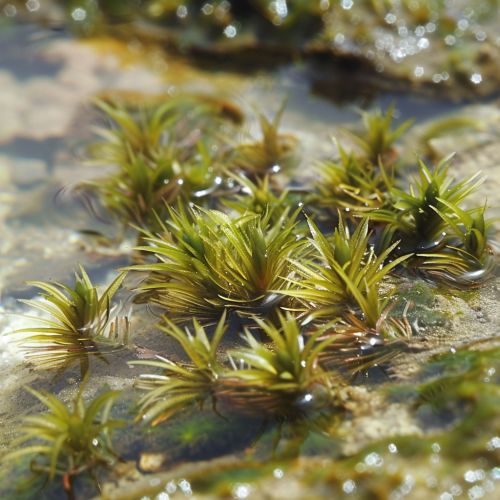Charophyta
Introduction
Charophyta, also known as charophytes, is a division of green algae that are considered to be the closest relatives of land plants. This group is significant in the study of plant evolution due to its unique characteristics that bridge the gap between aquatic algae and terrestrial plants. Charophytes are predominantly freshwater algae and can be found in a variety of aquatic environments, including ponds, lakes, and slow-moving streams.
Taxonomy and Classification
Charophyta is a division within the kingdom Plantae. The classification of Charophyta has been subject to extensive research and debate, and it is divided into several classes, including Charophyceae, Coleochaetophyceae, Zygnematophyceae, and Klebsormidiophyceae. These classes are distinguished based on their morphological and genetic characteristics.
Charophyceae
Charophyceae, commonly known as stoneworts, are characterized by their complex multicellular structure and calcified cell walls. They exhibit a distinctive branching pattern and possess reproductive structures called oogonia and antheridia.
Coleochaetophyceae
Coleochaetophyceae are small, disc-shaped algae that grow attached to substrates. They are notable for their cellular organization and reproductive features, which are similar to those of land plants.
Zygnematophyceae
Zygnematophyceae, also known as conjugating green algae, include species such as Spirogyra and Zygnema. These algae are known for their unique mode of sexual reproduction called conjugation, where two filaments align and exchange genetic material.
Klebsormidiophyceae
Klebsormidiophyceae are filamentous algae that are often found in terrestrial and freshwater environments. They are considered to be one of the most primitive groups within Charophyta.
Morphology and Structure
Charophytes exhibit a wide range of morphological diversity, from simple unicellular forms to complex multicellular structures. The cell walls of charophytes contain cellulose, and many species also have calcified walls, which contribute to their rigidity and structural integrity.


Cellular Structure
The cells of charophytes contain chloroplasts, which are the sites of photosynthesis. These chloroplasts contain chlorophyll a and b, similar to those found in land plants. The presence of pyrenoids, which are involved in carbon fixation, is another characteristic feature of charophyte cells.
Reproductive Structures
Charophytes reproduce both sexually and asexually. Sexual reproduction involves the formation of specialized structures such as oogonia (female) and antheridia (male). Asexual reproduction occurs through fragmentation or the production of spores.
Ecology and Habitat
Charophytes are predominantly found in freshwater environments, although some species can tolerate brackish conditions. They play a crucial role in aquatic ecosystems by providing habitat and food for various organisms. Charophytes also contribute to the stabilization of sediments and the cycling of nutrients within their habitats.
Freshwater Ecosystems
In freshwater ecosystems, charophytes can form dense mats or meadows, which provide shelter and breeding grounds for invertebrates and fish. They also help to improve water quality by absorbing nutrients and reducing turbidity.
Brackish Environments
Some charophytes are adapted to brackish environments, where they can tolerate varying levels of salinity. These species are often found in estuaries and coastal lagoons, where they contribute to the overall biodiversity and productivity of these habitats.
Evolutionary Significance
Charophytes are considered to be the closest living relatives of land plants, and their study provides valuable insights into the transition from aquatic to terrestrial life. The similarities in cellular structure, reproductive features, and genetic makeup between charophytes and land plants suggest a common evolutionary origin.
Phylogenetic Studies
Phylogenetic studies using molecular data have shown that charophytes share a common ancestor with land plants. The presence of similar genes involved in cell wall synthesis, photosynthesis, and reproductive processes supports this evolutionary relationship.
Fossil Record
The fossil record of charophytes dates back to the Silurian period, providing evidence of their long evolutionary history. Fossilized remains of charophyte oogonia and calcified structures have been found in sedimentary rocks, indicating their presence in ancient aquatic environments.
Research and Applications
Charophytes are of interest not only for their evolutionary significance but also for their potential applications in various fields. Research on charophytes has implications for understanding plant biology, ecology, and environmental science.
Environmental Indicators
Charophytes are used as bioindicators to assess the health of aquatic ecosystems. Their sensitivity to changes in water quality, such as nutrient levels and pollution, makes them valuable tools for monitoring environmental conditions.
Biotechnological Applications
The unique properties of charophytes, such as their ability to accumulate heavy metals and produce bioactive compounds, have potential applications in biotechnology. Research is ongoing to explore their use in bioremediation, pharmaceuticals, and other industries.
